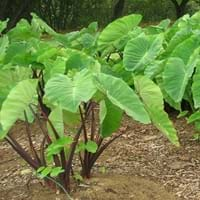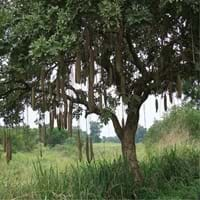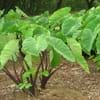Life Span
Annual
Perennial
Type
Tender Perennial
Tree
Origin
Southeastern Asia
Eastern Africa, Middle Africa
Types
Eddoe taro, Dasheen taro
Not Available
Number of Varieties
Not Available
Habitat
agricultural areas, Hillside, Warm and moist climatic conditions
Riverine forest, wooded grassland
USDA Hardiness Zone
10-11
9-12
Sunset Zone
H1, H2, 22, 23, 24
H1, H2, 12, 13, 19, 20, 21, 22, 23, 24
Habit
Clump-Forming
Arching/Fountain-shaped
Flower Color
White, Green
Dark Red, Tan
Flower Color Modifier
Not Available
Bicolor
Leaf Color in Spring
Dark Green, Ivory
Green, Dark Green
Leaf Color in Summer
Dark Green, Ivory
Green, Dark Green
Leaf Color in Fall
Dark Green, Ivory
Green, Dark Green
Leaf Color in Winter
Dark Green, Ivory
Not Available
Leaf Shape
V-Shaped
Pinnate
Plant Season
Spring, Summer, Fall, Winter
Spring, Summer, Fall, Winter
Sunlight
Partial shade, Full Shade
Full Sun
Type of Soil
Loam, Sand
Loam, Sand
The pH of Soil
Acidic, Neutral
Acidic, Neutral, Alkaline
Soil Drainage
Well drained
Average
Bloom Time
Indeterminate
Indeterminate
Tolerances
Heat Tolerance, Humidity, Salt and Soil Compaction, Shallow soil
Drought, Salt
Where to Plant?
Container
Ground
How to Plant?
From Rhizomes
Seedlings
Plant Maintenance
Medium
Medium
Watering Requirements
Needs 2-3 times watering per week, Needs a lot of water initially
Needs a lot of water initially
In Summer
Lots of watering
Lots of watering
In Spring
Moderate
Moderate
In Winter
Average Water
Average Water
Soil pH
Acidic, Neutral
Acidic, Neutral, Alkaline
Soil Type
Loam, Sand
Loam, Sand
Soil Drainage Capacity
Well drained
Average
Sun Exposure
Partial shade, Full Shade
Full Sun
Pruning
Not Available
Remove damaged leaves, Remove dead branches, Remove dead leaves
Fertilizers
All-Purpose Liquid Fertilizer, Less fertilizing
Balanced liquid fertilizer monthly
Pests and Diseases
Aphids, Rats, Snails
Leaf spot, Mealybugs, Rust
Plant Tolerance
Heat Tolerance, Salt and Soil Compaction, Shade areas
Drought
Flowers
Insignificant
Showy
Flower Petal Number
Not Available
Single
Foliage Texture
Bold
Coarse
Foliage Sheen
Glossy
Glossy
Attracts
Aphids, Bugs, Not Available, Snails
Bees, Birds, Butterflies, Not Available
Allergy
Swelling in mouth, Throat itching
Poisonous when unripe
Aesthetic Uses
Showy Purposes
Not Available
Beauty Benefits
Poison Ivy, Skin cleanser, Weightloss
Acne, Slow downs aging
Environmental Uses
No fertilizer, pesticides, or herbicides needed, Prevent weeds
Air purification
Medicinal Uses
Aging, Laxative, Weight loss
Gynaecological, Malaria, STDs
Part of Plant Used
Leaf Stalks, Leaves
Dried seeds, Leaves
Other Uses
Used As Food, Used as Ornamental plant
Used to flavour beer, Used to produce a red dye
Used As Indoor Plant
No
No
Used As Outdoor Plant
Yes
Yes
Garden Design
Container, Feature Plant, Groundcover, Houseplant, Mixed Border, Tropical
Feature Plant, Shade Trees, Tropical
Botanical Name
ALOCASIA micholitziana
KIGELIA africana
Common Name
Elephant Ear, Taro
Sausage Tree
In Hindi
अरवी
Sausage Tree
In German
Colocasia (Pflanzengattung)
Sausage Tree
In French
Colocasia
saucisse Arbre
In Spanish
Colocasia
Árbol de salchicha
In Greek
Colocasia
λουκάνικο δέντρο
In Portuguese
Colocasia
Árvore de salsicha
In Polish
Kolokazja
kiełbasa Drzewo
In Latin
Colocasia
farciminis ligno
Phylum
Magnoliophyta
Magnoliophyta
Class
Liliopsida
Magnoliopsida
Family
Araceae
Bignoniaceae
Genus
Alocasia
Kaempferia
Clade
Angiosperms, Monocots
Angiosperms, Asterids, Eudicots
Tribe
Colocasiodeae
Tecomeae
Subfamily
Aroideae
Not Available
Number of Species
Not Available
Importance of Taro and Sausage Tree
Want to have the most appropriate plant for your garden? You might want to know the importance of Taro and Sausage Tree. Basically, these two plants vary in many aspects. Compare Taro and Sausage Tree as they differ in many characteristics such as their life, care, benefits, facts, etc. Every gardener must at least have the slightest clue about the plants he wants to plant in his garden. Compare their benefits, which differ in many ways like facts and uses. The medicinal use of Taro is Aging, Laxative and Weight loss whereas of Sausage Tree is Gynaecological, Malaria and STDs. Taro has beauty benefits as follows: Poison Ivy, Skin cleanser and Weightloss while Sausage Tree has beauty benefits as follows: Poison Ivy, Skin cleanser and Weightloss.
Compare Facts of Taro vs Sausage Tree
How to choose the best garden plant for your garden depending upon its facts? Here garden plant comparison will help you to solve this query. Compare the facts of Taro vs Sausage Tree and know which one to choose. As garden plants have benefits and other uses, allergy is also a major drawback of plants for some people. Allergic reactions of Taro are Swelling in mouth and Throat itching whereas of Sausage Tree have Poisonous when unripe respectively. Having a fruit bearing plant in your garden can be a plus point of your garden. Taro has no showy fruits and Sausage Tree has showy fruits. Also Taro is not flowering and Sausage Tree is not flowering . You can compare Taro and Sausage Tree facts and facts of other plants too.





